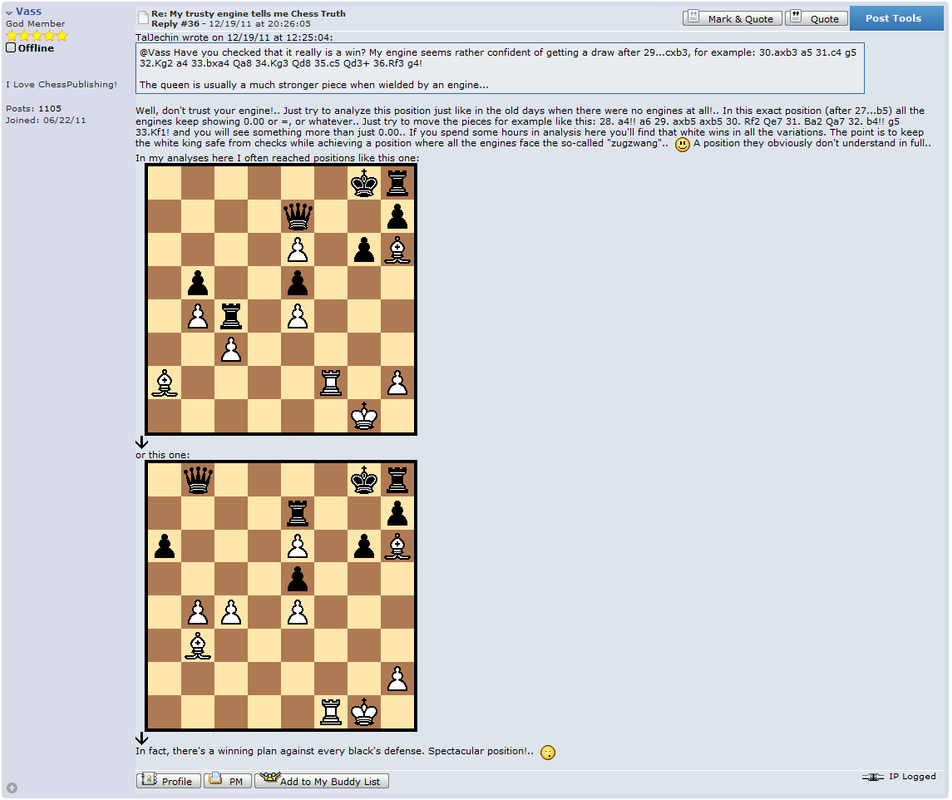Molniya Sports Society 1946
Sicilian Defense, Dragon, Classical 6.Be2 without Be3 (ECO B70)
Annotations by Y. Gusev
1.e4 c5
2.Nf3 d6
3.d4 cxd4
4.Nxd4 Nf6
5.Nc3 g6
6.Be2 Nc6
7.Nb3 Bg7
8.O-O
| 8 | |||||||||
| 7 | |||||||||
| 6 | |||||||||
| 5 | |||||||||
| 4 | |||||||||
| 3 | |||||||||
| 2 | |||||||||
| 1 | |||||||||
| a | b | c | d | e | f | g | h |
r1bqk2r/pp2ppbp/2np1np1/8/4P3/1NN5/PPP1BPPP/R1BQ1RK1 b kq - 0 8
The correct continuation in this position is 8...0-0 and on 9.0-0 there follows 9...b5, equalizing. This maneuver has been recommended by V. Rauzer.
9.f4 Rc8
10.f5 Bd7
11.g4 Ne5
12.g5 Ng8
13.Nd5 f6
14.Be3 b6
15.Nd4 Kf7
| 8 | |||||||||
| 7 | |||||||||
| 6 | |||||||||
| 5 | |||||||||
| 4 | |||||||||
| 3 | |||||||||
| 2 | |||||||||
| 1 | |||||||||
| a | b | c | d | e | f | g | h |
2rq2nr/p2bpkbp/1p1p1pp1/3NnPP1/3NP3/4B3/PPP1B2P/R2Q1RK1 w - - 0 16
Intending 17.Qb3.
16...Qe8 17.Ne6!
Threatening to win immediately with 18.Nd5-c7.
17...Bxe6 18.fxe6+
| 8 | |||||||||
| 7 | |||||||||
| 6 | |||||||||
| 5 | |||||||||
| 4 | |||||||||
| 3 | |||||||||
| 2 | |||||||||
| 1 | |||||||||
| a | b | c | d | e | f | g | h |
2r1q1nr/p3pkbp/1p1pPpp1/3Nn1P1/4P3/2P1B3/PP2B2P/R2Q1RK1 b - - 0 18
Not 18...Kxe6? because of 19.Qb3 Kd7 20.Qa4+ Kd8 21.Qxa7 and White wins.
19.Nxf6! Nxf6
19...exf6 is met with 20.Qxd6+, followed by 21.Qxe5
20.gxf6 Bxf6
| 8 | |||||||||
| 7 | |||||||||
| 6 | |||||||||
| 5 | |||||||||
| 4 | |||||||||
| 3 | |||||||||
| 2 | |||||||||
| 1 | |||||||||
| a | b | c | d | e | f | g | h |
2r1qk1r/p3p2p/1p1pPbp1/4n3/4P3/2P1B3/PP2B2P/R2Q1RK1 w - - 0 21
Here White was presented with the choice between 21.Bg5 Kg7 22.Bxf6+ exf6 23.Qxd6, winning a pawn but leaving the opponent with a strong knight on e5, and the chance to continue the attack. White picks the second option.
21.Bh6+ Kg8
22.Rxf6 exf6
23.Qxd6 Rc6
| 8 | |||||||||
| 7 | |||||||||
| 6 | |||||||||
| 5 | |||||||||
| 4 | |||||||||
| 3 | |||||||||
| 2 | |||||||||
| 1 | |||||||||
| a | b | c | d | e | f | g | h |
4q1kr/p6p/1prQPppB/4n3/4P3/2P5/PP2B2P/R5K1 w - - 0 24
24.Qxe5!! fxe5 25.Rf1!
| 8 | |||||||||
| 7 | |||||||||
| 6 | |||||||||
| 5 | |||||||||
| 4 | |||||||||
| 3 | |||||||||
| 2 | |||||||||
| 1 | |||||||||
| a | b | c | d | e | f | g | h |
4q1kr/p6p/1pr1P1pB/4p3/4P3/2P5/PP2B2P/5RK1 b - - 0 25
An extremely interesting position has arisen. White has a rook and two bishops vs. the opponent's queen and two rooks; however, Black's rook on h8 is out of play, his king doesn't have a single move whereas the undefended white pawn on e6 turns out to be as strong as the queen. For example, 25...Rxe6 27.Bc4. The immediate threat is 26.Bb5
Rc8 26.Bd1
Now 26...Qxe6 is met with 27.Bb3 Qxb3 28.axb3 and White wins by moving his king to the queenside and creating a passed pawn there. Therefore Black cannot take the e6 pawn. Meanwhile White threatens a decisive transfer of the bishop to the a2-g8 diagonal, e.g. 26...Rc7 27.Bb3 Re7 28.Bd5, and after the queen moves the invasion of the rook on f7 immediately decides the game. Black blocks the dangerous diagonal with the exchange sacrifice.
26...Rc4 27.Bb3 b5 28.Bxc4 bxc4
| 8 | |||||||||
| 7 | |||||||||
| 6 | |||||||||
| 5 | |||||||||
| 4 | |||||||||
| 3 | |||||||||
| 2 | |||||||||
| 1 | |||||||||
| a | b | c | d | e | f | g | h |
4q1kr/p6p/4P1pB/4p3/2p1P3/2P5/PP5P/5RK1 w - - 0 29
29.b3
29.b4 at once was more accurate.
29...a5
Now 30.b4 runs into 30...axb4 31.c3b4 c3! and with the pawn bound to queen it is Black who wins!
30.bxc4 Qe7 31.Kg2 Qa3 32.Rf2 Qe7 33.Rf1 g5 34.Rf5 g4
| 8 | |||||||||
| 7 | |||||||||
| 6 | |||||||||
| 5 | |||||||||
| 4 | |||||||||
| 3 | |||||||||
| 2 | |||||||||
| 1 | |||||||||
| a | b | c | d | e | f | g | h |
6kr/4q2p/4P2B/p3pR2/2P1P1p1/2P5/P5KP/8 w - - 0 35
35.c5 Qd8 36.c6 Qe7 37.c7
Black resigns
References:
- Shakhmaty v SSSR 10/1951, p. 300 as listed in Chess Notes
- Edward Winter's Chess Notes #8405 - info on Black's name, year and venue
- Chessgames.com - discussion and analysis going back to 2007
- Test Position 2 - CCC thread from 2007 dedicated to the queen sacrifice
- My trusty engine tells me Chess Truth - a ChessPub thread from 2011 dedicated to engine-buster positions. Note: the thread's first post is at the bottom of the page if you are not logged in, so read from the bottom to the top. The discussion of Gusev-Auerbach starts with this post by Vass (a Bulgarian, not to be confused with Vas the Czech ;).
- Vass' groundbreaking discovery of 28.a4! (reply #36 in the ChessPub thread above)
- Looking for a mechanical solution to 11 Epd problems -- Louis Zulli's SF observations in this 2015 CCC thread
- This author's 2015 analysis on Chessgames, starts with this post
- "Poor Fish": very hard test suite - Gusev's namesake recommends the queen sacrifice position for inclusion in Marco Costalba SF-challenging suite in this 2016 CCC thread; some discussion follows
- Defence vs. Attack - further comments, analysis and some background info by this author in a CCC thread from 2017.
